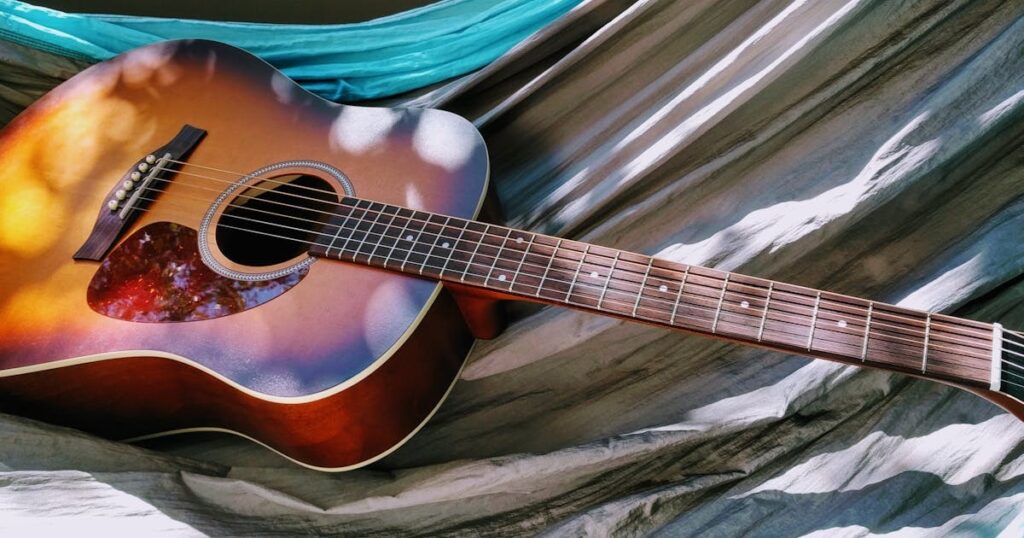Key takeaway: Understanding the anatomy of a acoustic guitar is crucial for both players and enthusiasts. Familiarity with its parts, materials, and construction enhances appreciation and informs maintenance, ultimately leading to a richer musical experience and improved instrument longevity.
As one of the most popular musical instruments in the world, the acoustic guitar has become synonymous with music and culture. Its distinctive sound and versatility have made it a favourite among musicians from all genres, from folk to rock to pop.

But what makes an acoustic guitar unique? What are its parts, materials, and construction that contribute to its distinct sound?
In this article, we will take a closer look at the anatomy of an acoustic guitar, discussing its various components, materials, and construction techniques that make it such a beloved instrument.
The Parts of an Acoustic Guitar
An acoustic guitar is made up of several essential parts that work together to create its distinctive sound. Let’s take a closer look at each of these parts and their functions.
Body
The body of an acoustic guitar is typically made up of three main components: the top, back, and sides. The top, also known as the soundboard, is usually made of spruce or cedar wood and is responsible for amplifying the vibrations from the strings.
The back and sides are often made of mahogany, rosewood or maple wood and help reflect and project the sound produced by the top.
Neck
The neck of an acoustic guitar connects the body to the headstock and holds the fretboard. It is typically made of hardwood such as mahogany or maple and may have a truss rod to adjust the tension of the strings.

Fretboard
The fretboard is the long, thin piece of wood attached to the neck of an acoustic guitar. It typically has metal frets embedded into it, which help create different notes when pressed down by the player’s fingers.
Headstock
The headstock is located at the end of the neck and holds the tuning pegs, which are used to tighten or loosen the strings and adjust their pitch. The headstock also contains the nut, a small piece of plastic or bone that helps hold the strings in place and maintain proper spacing between them.
Bridge
Located on the body of an acoustic guitar, the bridge is where the strings are anchored. It typically has a saddle made of bone or plastic that helps transmit vibrations from the strings to the body of the guitar.
Soundhole
The soundhole is located on the top of an acoustic guitar and plays a crucial role in projecting the sound produced by the instrument. Its size and shape impact both volume and tone, making it an essential part of an acoustic guitar’s anatomy.
Materials and Construction
Apart from its various components, the materials used in an acoustic guitar’s construction also contribute significantly to its overall sound quality. Let’s take a closer look at some common materials used in building these instruments.
Wood
Wood is the most essential material in an acoustic guitar’s construction, as it affects both its sound and appearance. Different types of wood can produce different tones and resonance, making each guitar unique. Some popular woods used include spruce, cedar, mahogany, rosewood, and maple.

Glue
Glue is another crucial component in building an acoustic guitar. It helps bond different pieces of wood together to create a sturdy and resonant structure. The type of adhesive used can affect the overall sound quality of the instrument.
Bracing
Bracing refers to the internal wooden structures inside an acoustic guitar that help distribute vibrations from the strings across the top and back of the instrument. These braces are carefully placed and shaped to help achieve the desired sound.
FAQs
How is an acoustic guitar different from an electric guitar?
An acoustic guitar produces sound acoustically, without any external amplification. On the other hand, an electric guitar requires an amplifier to produce a louder sound.
Can I play an acoustic guitar with a pick?
Yes, you can use a pick to strum or pluck the strings of an acoustic guitar. However, some players prefer using their fingers for a softer and more nuanced sound.
What should I look for when buying an acoustic guitar?
When buying an acoustic guitar, consider its size, shape, materials used, and overall feel and sound. It’s always best to try out different guitars and choose one that feels comfortable and sounds good to your ears.
Conclusion: anatomy of a acoustic guitar
The anatomy of an acoustic guitar is a combination of its various components, materials, and construction techniques. Each part plays a crucial role in creating the unique sound of this beloved instrument.
So next time you strum a chord or pluck a string on your acoustic guitar, remember the intricate design and craftsmanship that goes into making it such a versatile and iconic musical instrument.
So whether you’re just starting to learn how to play or have been playing for years, take some time to appreciate the complexity and beauty of the anatomy of an acoustic guitar.
